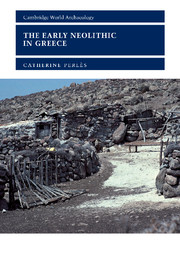Book contents
- Frontmatter
- Contents
- List of figures
- List of tables
- Acknowledgements
- Introduction
- 1 The land and its resources: the geographic context
- 2 The Mesolithic background
- 3 The introduction of farming: local processes, diffusion or colonization?
- 4 Foreign colonists: where from?
- 5 The earliest Neolithic deposits: ‘aceramic’, ‘pre-pottery’ or ‘ceramic’?
- 6 The spread of the Early Neolithic in Greece: chronological and geographical aspects
- 7 A case study in Early Neolithic settlement patterns: eastern Thessaly
- 8 Early Neolithic subsistence economy: the domestic and the wild
- 9 The Early Neolithic village
- 10 Craft specialization: the contrasting cases of chipped-stone tools, pottery and ornaments
- 11 A variety of daily crafts
- 12 Ritual interaction? The miniature world of ‘dolls or deities’
- 13 Interacting with the dead: from the disposal of the body to funerary rituals
- 14 Interactions among the living
- Conclusion
- Bibliography
- Index
4 - Foreign colonists: where from?
Published online by Cambridge University Press: 18 December 2009
- Frontmatter
- Contents
- List of figures
- List of tables
- Acknowledgements
- Introduction
- 1 The land and its resources: the geographic context
- 2 The Mesolithic background
- 3 The introduction of farming: local processes, diffusion or colonization?
- 4 Foreign colonists: where from?
- 5 The earliest Neolithic deposits: ‘aceramic’, ‘pre-pottery’ or ‘ceramic’?
- 6 The spread of the Early Neolithic in Greece: chronological and geographical aspects
- 7 A case study in Early Neolithic settlement patterns: eastern Thessaly
- 8 Early Neolithic subsistence economy: the domestic and the wild
- 9 The Early Neolithic village
- 10 Craft specialization: the contrasting cases of chipped-stone tools, pottery and ornaments
- 11 A variety of daily crafts
- 12 Ritual interaction? The miniature world of ‘dolls or deities’
- 13 Interacting with the dead: from the disposal of the body to funerary rituals
- 14 Interactions among the living
- Conclusion
- Bibliography
- Index
Summary
Paradoxically, even if the Near Eastern origin of several domesticated species is now well established, the precise origin of the farmers themselves remains as elusive as ever. No satisfactory link has been established with any specific region of the Near or Middle East, and the most obvious candidate, western Turkey, has not yet provided evidence of Neolithic settlements as early as those of Greece.
The ‘random’ parallels between Greece and the Near East
Depending on whether one envisions a rapid or a slow movement of expansion, the reference sites for comparisons differ. According to the model of Ammerman and Cavalli-Sforza, western Anatolia and Greece belong to the same isochron. This would imply a roughly simultaneous expansion of farming groups in the two areas (Ammerman and Cavalli-Sforza 1984). Given the dates of the earliest Neolithic sites in Greece, the best comparenda should thus belong to the Final Pre-Pottery Neolithic B (PPNB) and the Early Pottery Neolithic of the Near East, that is, to phase 5 (6900–6400 cal BC) in the general chronological scheme of Aurenche et al. (1987; see also Cauvin 1985).
Yet, if the spread of farming groups were a slow movement, it would be more appropriate to turn to earlier sites, of the late phase 4 (late PPNB, c. 7600–6900 BC). The Late PPNB was indeed qualified by Cauvin (1989: 19; 1994: 107ff.) as the period of the ‘great exodus’, when Initial Neolithic farming groups started to migrate out of the ‘nuclear zone’ and to colonize the Taurus, central Anatolia, the deserts and the temperate Mediterranean zone.
- Type
- Chapter
- Information
- The Early Neolithic in GreeceThe First Farming Communities in Europe, pp. 52 - 63Publisher: Cambridge University PressPrint publication year: 2001



